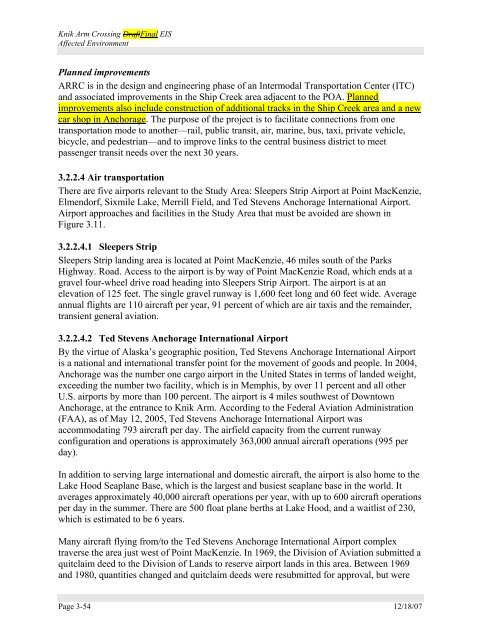3.0 Affected Environment - Knik Arm Bridge and Toll Authority
3.0 Affected Environment - Knik Arm Bridge and Toll Authority
3.0 Affected Environment - Knik Arm Bridge and Toll Authority
You also want an ePaper? Increase the reach of your titles
YUMPU automatically turns print PDFs into web optimized ePapers that Google loves.
<strong>Knik</strong> <strong>Arm</strong> Crossing DraftFinal EIS<br />
<strong>Affected</strong> <strong>Environment</strong><br />
Planned improvements<br />
ARRC is in the design <strong>and</strong> engineering phase of an Intermodal Transportation Center (ITC)<br />
<strong>and</strong> associated improvements in the Ship Creek area adjacent to the POA. Planned<br />
improvements also include construction of additional tracks in the Ship Creek area <strong>and</strong> a new<br />
car shop in Anchorage. The purpose of the project is to facilitate connections from one<br />
transportation mode to another—rail, public transit, air, marine, bus, taxi, private vehicle,<br />
bicycle, <strong>and</strong> pedestrian—<strong>and</strong> to improve links to the central business district to meet<br />
passenger transit needs over the next 30 years.<br />
3.2.2.4 Air transportation<br />
There are five airports relevant to the Study Area: Sleepers Strip Airport at Point MacKenzie,<br />
Elmendorf, Sixmile Lake, Merrill Field, <strong>and</strong> Ted Stevens Anchorage International Airport.<br />
Airport approaches <strong>and</strong> facilities in the Study Area that must be avoided are shown in<br />
Figure 3.11.<br />
3.2.2.4.1 Sleepers Strip<br />
Sleepers Strip l<strong>and</strong>ing area is located at Point MacKenzie, 46 miles south of the Parks<br />
Highway. Road. Access to the airport is by way of Point MacKenzie Road, which ends at a<br />
gravel four-wheel drive road heading into Sleepers Strip Airport. The airport is at an<br />
elevation of 125 feet. The single gravel runway is 1,600 feet long <strong>and</strong> 60 feet wide. Average<br />
annual flights are 110 aircraft per year, 91 percent of which are air taxis <strong>and</strong> the remainder,<br />
transient general aviation.<br />
3.2.2.4.2 Ted Stevens Anchorage International Airport<br />
By the virtue of Alaska’s geographic position, Ted Stevens Anchorage International Airport<br />
is a national <strong>and</strong> international transfer point for the movement of goods <strong>and</strong> people. In 2004,<br />
Anchorage was the number one cargo airport in the United States in terms of l<strong>and</strong>ed weight,<br />
exceeding the number two facility, which is in Memphis, by over 11 percent <strong>and</strong> all other<br />
U.S. airports by more than 100 percent. The airport is 4 miles southwest of Downtown<br />
Anchorage, at the entrance to <strong>Knik</strong> <strong>Arm</strong>. According to the Federal Aviation Administration<br />
(FAA), as of May 12, 2005, Ted Stevens Anchorage International Airport was<br />
accommodating 793 aircraft per day. The airfield capacity from the current runway<br />
configuration <strong>and</strong> operations is approximately 363,000 annual aircraft operations (995 per<br />
day).<br />
In addition to serving large international <strong>and</strong> domestic aircraft, the airport is also home to the<br />
Lake Hood Seaplane Base, which is the largest <strong>and</strong> busiest seaplane base in the world. It<br />
averages approximately 40,000 aircraft operations per year, with up to 600 aircraft operations<br />
per day in the summer. There are 500 float plane berths at Lake Hood, <strong>and</strong> a waitlist of 230,<br />
which is estimated to be 6 years.<br />
Many aircraft flying from/to the Ted Stevens Anchorage International Airport complex<br />
traverse the area just west of Point MacKenzie. In 1969, the Division of Aviation submitted a<br />
quitclaim deed to the Division of L<strong>and</strong>s to reserve airport l<strong>and</strong>s in this area. Between 1969<br />
<strong>and</strong> 1980, quantities changed <strong>and</strong> quitclaim deeds were resubmitted for approval, but were<br />
Page 3-54 12/18/07
















